A perfect masculine woody fragrance starts with powerful base notes like cedarwood, sandalwood, or oud as your foundation. You'll want to balance these deep woods with complementary elements like bright citrus top notes and warming spices in the middle. Consider seasonal factors when choosing your blend – lighter woods for summer, richer combinations for winter. The key lies in mastering the delicate interplay between bold and subtle notes for a sophisticated signature scent. There's much more to discover about crafting your ideal woody fragrance.
The Foundation of Woody Base Notes
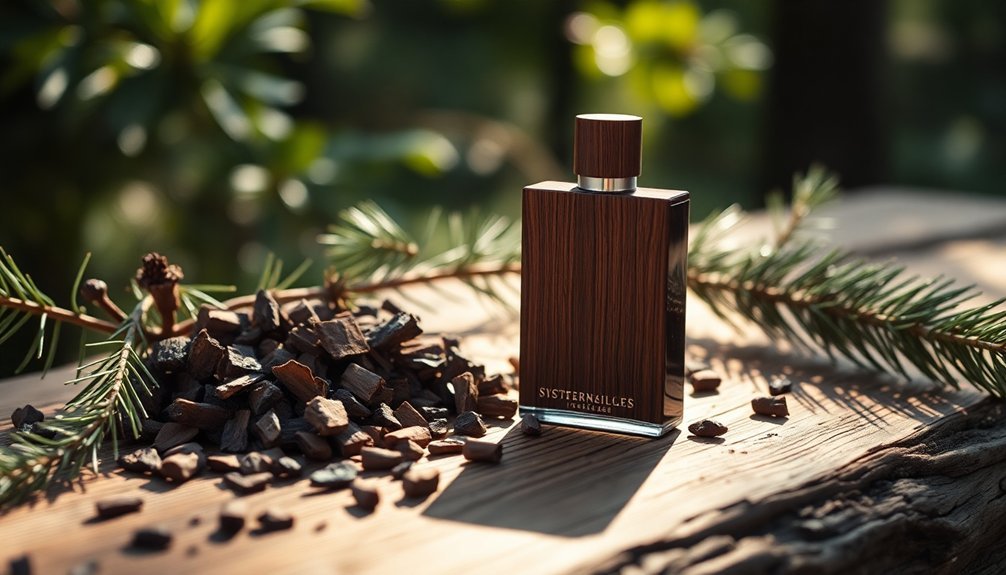
Woody base notes form the backbone of masculine fragrances, acting as the essential foundation that gives a scent its lasting power and depth.
You'll find classic woods like sandalwood, cedarwood, and vetiver anchoring your favorite men's scents, ensuring they stay present throughout the day.
What makes these notes particularly effective is their ability to interact seamlessly with other fragrance families. The rich complexity of these ingredients helps them enrich other notes, making them integral to modern perfumery.
You can pair them with citrus for a fresh twist, blend them with orientals for added richness, or combine them with florals to create a more balanced masculine appeal.
When you're looking for a sophisticated scent, consider fragrances that feature multiple woody notes working together.
This layering creates complexity while maintaining the grounding quality that's essential in men's perfumery.
Essential Woods for Masculine Appeal
Choosing the right woody notes forms the backbone of a masculine fragrance, with cedarwood and sandalwood serving as your essential starting points.
You'll want to create a balanced blend by layering these foundational woods with complementary notes like oud or vetiver, which add depth without overwhelming the composition.
The key to achieving a powerful yet refined masculine scent lies in understanding how to combine these woods with the right proportion of earthy and resinous elements. These combinations work especially well during autumn and winter months, when woody fragrances naturally complement the seasonal atmosphere.
Core Woods Every Man Needs
The foundation of any masculine fragrance lies in its wood notes, which serve as the backbone of timeless appeal.
You'll find that woods like cedarwood, oud, sandalwood, and vetiver create distinct signatures that define sophisticated masculinity. Each wood brings its unique character, from cedarwood's resinous warmth to oud's exotic smokiness. The woody aromatic blend creates a perfect balance suitable for both daytime and evening wear.
- Cedarwood and vetiver pair exceptionally well together, offering both aromatic depth and crisp freshness that's perfect for year-round wear.
- Sandalwood's smooth, spicy profile works beautifully with other woods, creating a seductive base that's both warm and luxurious.
- Oud's distinctive earthy character adds an oriental touch that's particularly striking when you're looking for something unique and memorable.
These core woods aren't just ingredients; they're essential elements that'll elevate your fragrance game to new heights.
Balancing Woods With Strength
When crafting a masculine wood-based fragrance, you'll need to master the delicate art of balance and strength. You'll find that oud and sandalwood form powerful base notes, offering the endurance needed for long-lasting appeal. Combine these with complementary elements to create a sophisticated signature scent.
| Wood Type | Strength Level | Best Pairings |
|---|---|---|
| Oud | Very Strong | Spices, Amber |
| Sandalwood | Medium-Strong | Rose, Vanilla |
| Cedarwood | Medium | Citrus, Vetiver |
| Vetiver | Strong | Geranium, Tobacco |
For maximum impact, layer your woods with contrasting notes. Try pairing smoky oud with cardamom for an exotic edge, or blend sandalwood with vanilla for a warm, sophisticated finish. Remember that wood-based fragrances symbolize power and luxury, making them perfect for evening wear and formal occasions.
Balancing Dry and Resinous Woods
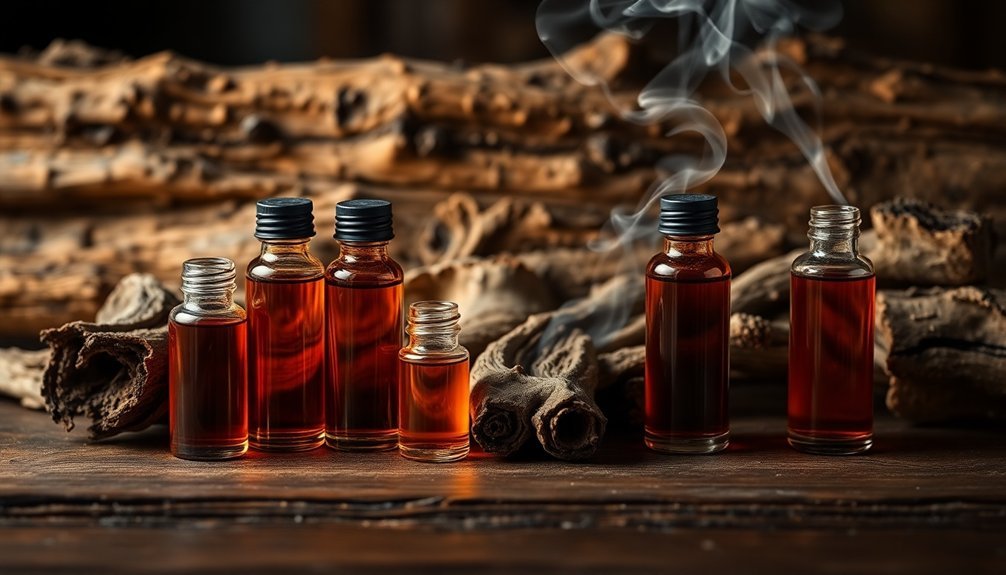
Successfully balancing dry and resinous woods requires a deep understanding of how these distinct elements complement each other in masculine fragrances.
You'll want to pair dry woods like cedarwood and sandalwood with rich resins such as benzoin and frankincense to create depth and complexity. The key is finding the right proportions, as resinous elements can quickly overpower the subtle nuances of dry woods.
- Start with a base of dry woods like sandalwood or cedarwood for structure.
- Add resinous elements gradually, beginning with lighter notes like frankincense before introducing heavier ones like myrrh.
- Consider seasonal factors – lighter blends work better in summer, while deeper resinous combinations shine in winter.
Remember to let your blend age properly, allowing the dry and resinous notes to meld into a harmonious composition that's perfect for your intended use.
Incorporating Spices With Woods
You'll find that warming spices create magic when paired thoughtfully with woods in masculine fragrances.
The combination works particularly well when you match Eastern woods like oud and sandalwood with Western spices such as cardamom and clove.
Whether you're layering fresh spices for brightness or warm spices for depth, the key is maintaining balance so neither element overshadows the other.
Warming Spices Meet Woods
The art of combining warming spices with woody notes creates a sophisticated masculine fragrance that's both grounding and inviting.
When you blend spices like cinnamon, nutmeg, and cloves with rich woods such as cedarwood or sandalwood, you'll discover a harmonious balance that adds depth and complexity to your scent. These warming spices perfectly complement the earthy, resinous qualities of woody base notes while making the fragrance more versatile.
To create your perfect woody-spice blend:
- Start with a strong woody base using cedarwood or sandalwood as your foundation.
- Layer in warming spices gradually, ensuring they don't overpower the wood notes.
- Balance the composition with lighter top notes like citrus or subtle florals to create a well-rounded fragrance.
Eastern Woods Western Spices
Combining Eastern woods with Western spices creates a sophisticated fusion that bridges ancient perfumery traditions with modern sensibilities.
You'll find agarwood, sandalwood, and cedarwood forming a rich base that harmonizes perfectly with spices like black pepper, cardamom, and cinnamon.
To achieve this balance, you'll want to layer your woods carefully. Start with agarwood's deep, sweet profile, then add sandalwood's creamy smoothness and cedarwood's fresh notes.
Next, introduce Western spices gradually – perhaps bergamot for brightness, followed by warming nutmeg or ginger.
Don't forget that a touch of musk or amber can enhance the blend's longevity and sensuality. This combination works especially well during colder months, though you'll find it's versatile enough for year-round wear.
Citrus Top Notes That Complement Woods
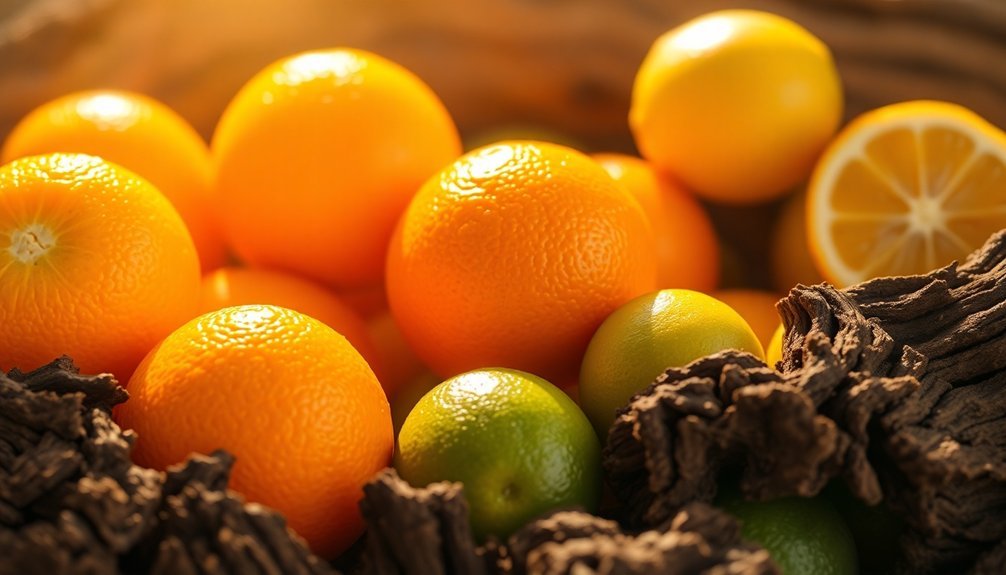
When crafting a masculine woody fragrance, selecting the right citrus top notes creates an essential bright opening that seamlessly shifts into deeper wood bases.
Bergamot's fresh yet slightly floral character pairs exceptionally well with cedarwood, while grapefruit's tangy profile adds an invigorating boost that complements sandalwood's warmth.
For a more complex blend, you'll find that mandarin or clementine can soften the overall composition while maintaining that desired citrus brightness.
- Combine bergamot with cedarwood for a classic, sophisticated blend that flows smoothly from day to night.
- Layer grapefruit over sandalwood to create a balanced profile that's both energizing and grounding.
- Add mandarin to birch or guaiac wood for a softer opening that still maintains masculine appeal while offering seasonal versatility.
The Art of Layering Woody Notes
You'll want to start with your preferred woody base notes like sandalwood or vetiver, allowing them to settle on your skin before adding complementary heart notes.
To create depth, layer lighter fragrances over your woody foundation in sequence, making sure each addition enhances rather than overwhelms the previous scent.
Using an unscented lotion as your first layer can help the woody notes blend more seamlessly with subsequent fragrances, creating a more cohesive and long-lasting masculine blend.
Blending Base and Heart
The art of layering woody notes requires a delicate balance between base and heart notes to create a harmonious masculine fragrance.
You'll want to start with strong woody base notes like sandalwood, cedarwood, or vetiver, then carefully blend in complementary heart notes that enhance rather than overpower the foundation.
To create a well-balanced woody fragrance:
- Select your primary woody base note (such as sandalwood for smoothness or cedarwood for dryness) and build upon it with modifiers like patchouli or oud.
- Add heart notes like lavender or geranium to bridge the gap between top and base notes, creating depth without overwhelming the woody character.
- Use blenders such as vanilla or tonka bean to smooth out any sharp edges and guarantee all elements work together seamlessly.
Depth Through Sequential Layering
Creating depth in woody fragrances relies on strategic sequential layering that builds complexity from the ground up.
Start by applying a light, woody-scented body lotion or oil as your foundation, ensuring it's appropriate for your skin type and the season. Once absorbed, introduce your main woody fragrance, such as cedarwood or sandalwood, focusing on pulse points.
You'll want to allow each layer to settle before adding complementary scents that enhance the woody notes.
Try mixing the fragrances on separate areas of skin, then gently blend them together. You can spotlight specific notes by incorporating contrasting scents, creating unexpected combinations that add dimension.
For maximum longevity, consider using the same fragrance in different forms, like combining a perfume with its matching body products.
Creating Depth With Aromatic Accents

When crafting a masculine woody fragrance, aromatic accents serve as essential building blocks that elevate the scent's complexity and appeal.
By incorporating herbal notes like lavender, rosemary, and thyme, you'll create a fresh, dynamic dimension that perfectly complements woody base notes. The key is striking the right balance between these aromatic elements and your foundation woods like sandalwood or cedar.
- Add mint or aniseed notes to the top layer for an immediate fresh impact and modern edge.
- Layer in lavender and herbal aromatics to bridge the gap between sharp top notes and rich base notes.
- Blend aromatic herbs strategically with woods to prevent the fragrance from becoming too heavy while maintaining its masculine character.
You can fine-tune the aromatic percentages to achieve your desired balance of freshness and woody depth.
Blending Woods With Leather Notes
Mastering the blend of woody and leather notes requires a deep understanding of their complementary nature and interaction.
You'll want to start by selecting compatible woody notes like cedarwood or sandalwood that harmonize naturally with leather accents.
When combining these elements, pay careful attention to their relative strengths. You can achieve balance by adjusting the proportions of each note and testing the blend on both blotter strips and skin.
Don't hesitate to experiment with different leather types – from smooth to rough – as base accents that ground your woody notes.
Remember to contemplate the fragrance wheel as your guide, but don't feel constrained by it.
You'll find success by blending kindred notes like amber with your woods, while maintaining the leather's presence as a foundational element in your composition.
Achieving the Perfect Oud Balance
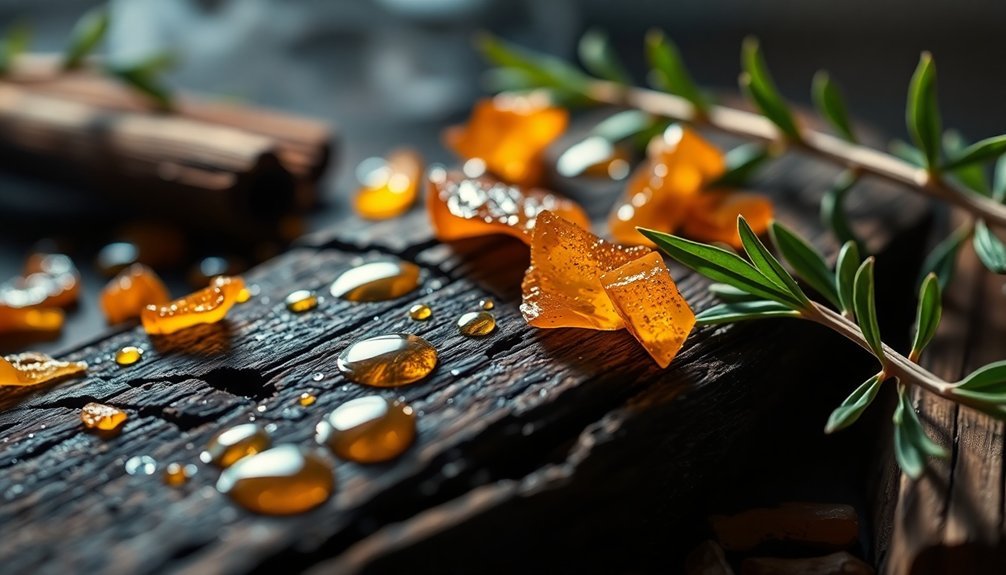
The art of balancing oud requires a delicate touch, as this precious ingredient can easily dominate a fragrance blend.
You'll find that complementary notes like rose, vanilla, or citrus can transform an overpowering oud into a perfectly balanced composition. For seasonal versatility, consider lighter interpretations with bergamot in warmer months, while saving richer, spicier blends for cooler weather.
- Pair oud with floral notes like rose for a sensual dimension, as seen in Dior Oud Ispahan, or with fruity elements like cherry for a modern twist.
- Layer with other woods such as sandalwood to distribute intensity, following Tom Ford Oud Wood's successful approach.
- Add spices like cardamom or cinnamon to enhance complexity while maintaining balance, similar to Atkinsons The Other Side of Oud.
Natural Vs Synthetic Woody Notes
Understanding the distinction between natural and synthetic woody notes can transform your approach to fragrance creation.
Natural woody notes, derived from trees and plants like sandalwood and cedarwood, offer authentic, complex aromas that create depth and sophistication in your blend. They're often perceived as more luxurious and can evoke stronger emotional responses.
However, don't overlook synthetic woody notes. They'll provide consistency and precision that nature can't always guarantee.
With options like vetiveryl acetate and vetiverol, you'll achieve clean, reliable scent profiles at a more accessible cost.
You'll find many modern fragrances successfully combining both natural and synthetic elements – like Guerlain Homme, which masterfully incorporates synthetic vetiver while maintaining its masculine appeal.
The key is striking the right balance between authenticity and reliability in your woody blend.
Seasonal Considerations for Woody Blends
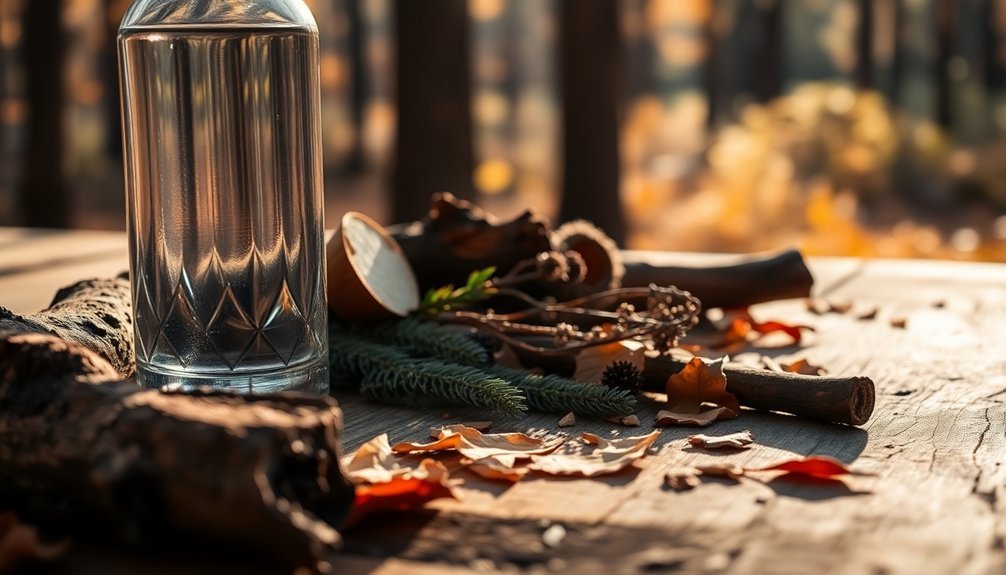
When creating masculine woody fragrances, seasonal changes greatly impact how your blend performs and resonates with wearers.
You'll need to adjust your formulations throughout the year, as temperature and humidity affect how scent molecules move through the air.
In winter, you'll want deeper, more resinous notes with spicy accents, while summer calls for lighter, citrus-infused woody blends that won't become overwhelming in the heat.
- Autumn/Winter: Focus on warm, earthy notes like sandalwood and cedarwood, enhanced with spices like cinnamon and clove for indoor comfort.
- Spring: Incorporate lighter woody notes with herbaceous accents and citrus top notes like Mandarin and Bergamot.
- Summer: Create balanced blends with invigorating citrus elements and light woody bases that won't become overpowering in high temperatures.
Longevity Enhancement Techniques
Creating long-lasting woody fragrances requires mastering several key techniques that work together to enhance their staying power.
Start by choosing an Eau de Parfum concentration, which contains 15-20% fragrance oils, ensuring your woody scent maintains its presence throughout the day.
To maximize longevity, apply your fragrance to well-moisturized skin, focusing on pulse points where body heat will help diffuse the scent.
You'll get better results if you layer complementary woody-scented products – try matching your body wash and moisturizer to your perfume's base notes.
Don't forget proper storage: keep your fragrances in a cool, dark place to maintain their potency.
For an extra boost in longevity, you can lightly mist your clothes (avoiding delicate fabrics) and let your hair act as a natural diffuser for the woody notes.
Signature Masculine Wood Combinations
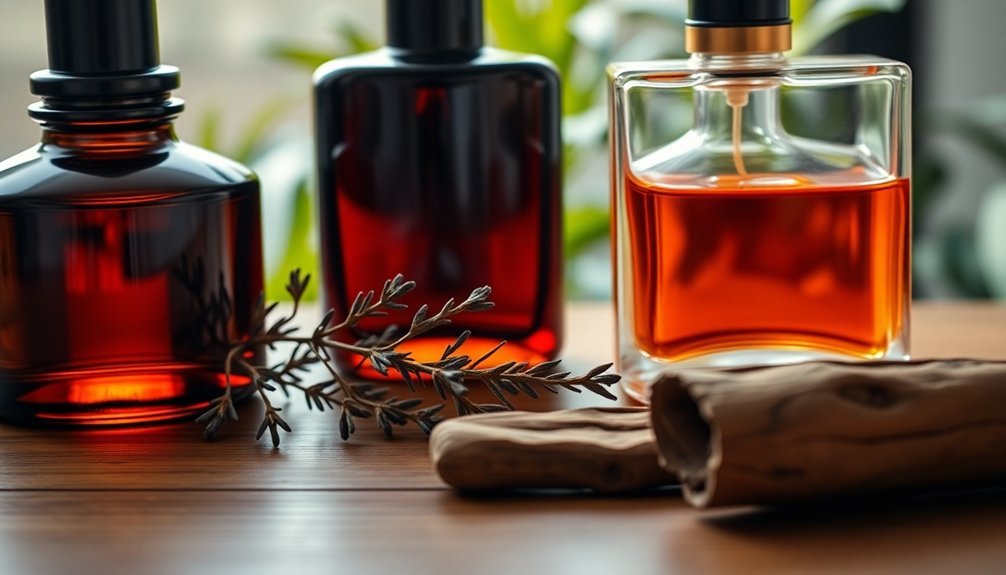
Mastering signature masculine wood combinations requires a thoughtful balance of complementary notes that work in harmony.
You'll find that the most successful blends start with a solid base of woods like sandalwood or cedarwood, enhanced by earthy vetiver or rich leather notes. These foundations create the perfect canvas for middle notes of tobacco, spices, or incense, while bright top notes of citrus or pine add that essential opening spark.
- Combine smoky oud with cedarwood for a bold statement, then soften it with hints of amber or orange blossom.
- Layer sandalwood and vetiver as your base, then add warmth with tobacco and spice notes like cinnamon.
- Create depth by mixing leather and oakmoss, then brighten with bergamot and juniper for a fresh, sophisticated edge.
Frequently Asked Questions
How Do Woody Fragrances Interact With Individual Body Chemistry?
Your skin's natural oils and pH levels blend with woody fragrances' base notes, creating deeper, warmer scents. They'll interact with your sweat components to produce a uniquely personal aroma that evolves throughout wear.
Can Woody Fragrances Be Inappropriate for Certain Professional Settings?
Yes, you'll need to avoid woody fragrances in healthcare settings, interviews, and shared workspaces. They can be too strong, trigger allergies, and distract others. Opt for lighter scents or no fragrance when appropriate.
What's the Ideal Age Range for Wearing Woody Fragrances?
You can wear woody fragrances at any age, but they're best matched to your life stage. Try fresh woods in your teens, aromatic blends in your thirties, and warmer, refined scents as you mature.
Do Woody Fragrances Affect Mood or Confidence Levels?
Yes, woody fragrances can boost your confidence and mood. You'll feel more grounded and self-assured when wearing these scents, as they're known to trigger positive memories and create a sense of strength.
How Do Climate and Humidity Impact Woody Fragrance Performance?
Your woody fragrances will last longer in cool, humid conditions but project stronger in heat. You'll notice better skin retention when it's humid, while dry climates cause faster evaporation and shorter longevity.
In Summary
You'll find that creating the perfect masculine woody fragrance comes down to masterful balance. Whether you're working with sandalwood, cedar, or oud, pair them thoughtfully with complementary spices and bright citrus notes. Don't shy away from mixing natural and synthetic ingredients to achieve peak performance. Remember, the best woody blends respect the seasons while maintaining their distinctive masculine character throughout the day.





Leave a Reply